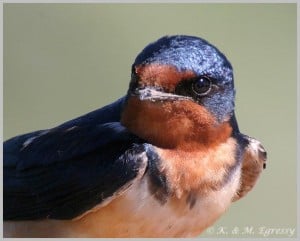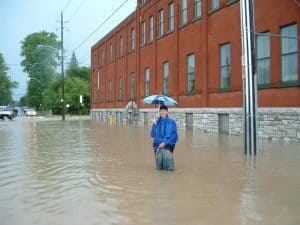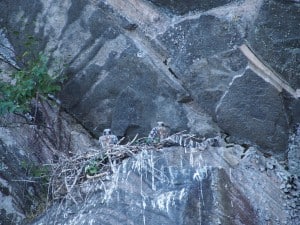2017 saw dire environmental stories grab centre stage but all was not doom and gloom
As we shiver into 2018, I would like to take a moment to look back at 2017 and revisit some of the top environmental and climate change stories. The past 12 months represent a stark cautionary tale that our climate is changing faster and with more catastrophic intensity than ever before. Scientists also reminded us this year that it is 100 percent human-caused. In fact, if it weren’t for Homo sapiens, the planet would be cooling.
To anyone paying attention, these changes are also apparent here in the Kawarthas where extremes in temperature and other weather events have become the norm. We might not know what the weather is going to bring, but we can be increasingly sure that it will be an extreme of some sort – and that it will last for much longer than ever before.
A year of extremes
1. Stronger storms: This was a savage year for hurricanes in the U.S. Three ferocious storms (Harvey, Irma and Maria) pummeled Florida, the Gulf Coast and Puerto Rico, causing deaths and billions of dollars of destruction. A growing scientific consensus is that climate change is increasing the rainfall, wind speeds and storm surges associated with hurricanes. Many experts believe that the intensity and frequency of these events will only increase.
2. Flooding: Ottawa and Montreal had their wettest spring on record with over 400 mm of rain falling. According to the Insurance Bureau of Canada, more than 5,000 residences were flooded. This resulted in 15,750 claims and $223 million in property damages. In April and May, Peterborough was drenched with 299 mm of rain, which was almost exactly double the 1981-2000 normal of 150 mm. In mid-May, water levels in Lake Ontario were their highest in 157 years.
On August 28, Windsor received 222 mm of rain in less than 48 hours. Insurance payouts totaled $154 million, which was the most expensive single-storm loss across Canada in 2017. This occurred less than a year after a record $153 million flood hit Windsor and Essex County in 2016.
3. Wildfires: British Columbia saw its longest and most destructive wildfire season ever. The BC Wildfire Service reported 1,265 fires that charred 1.2 million hectares of timber, bush and grassland. This represents an area twice the size of Prince Edward Island. It shattered the previous record for burned land by 30%. Fighting these fires cost the province more than half a billion dollars, while insured property losses approached $130 million. In California, too, the wildfire season was the most destructive in recorded history. This included the 20 most destructive fires ever seen in semi-urban areas. With climate change fueling more and bigger blazes, the Western wildfire season in the U.S. is now 105 days longer than it was 45 years ago.
4. Record heat: Planet-wide, 2017 will likely go down as the second-warmest year on record. What is most astounding is that this occurred in the absence of an El Niño, which drives up global temperatures. The hottest year ever was 2016, which broke the record set in 2015. The ten hottest years have all occurred since 1998. In eastern Canada, we saw “summer in September”. From September 22 to 27, over a thousand heat records fell. The mean monthly temperature in Peterborough was 2.6 C warmer than the 1971-2000 normal, while October temperatures soared an amazing 3.2 C above normal. To put this into context, the goal of the Paris Agreement is to limit planet-wide warming to well below 2 C.
5. Record cold: This December and January have been unbelievably frigid – once again thanks to the polar vortex. The mean December temperature in Peterborough came in at 3.2 C below normal – in other words, as much colder as October was warmer. It’s not just the severity of the cold, however; it’s also the duration. Outbreaks of cold weather almost never last this long. Bone-chilling Arctic air is projected to be with us through at least January 10.
So, doesn’t the cold mean that global warming is nothing to be concerned about – maybe even desirable? It’s important to remember that this is a short-term weather event and not a long-term climate trend. In fact, warmer-than-average air is dominating the rest of the planet right now.
The polar vortex is influenced by the temperature difference between the Arctic and more temperate regions to the south. In recent years, the Arctic has been warming at twice the global rate as sea ice melts. Many scientists now believe that the narrowing of the temperature difference between the Arctic and more southerly regions has caused the jet stream to weaken and become more wave-like. This weakening appears to have allowed Arctic air masses to spill southward and remain in place longer. In the past, a robust jet stream usually impeded Arctic air masses from spilling southward for more than a few days.
6. Donald Trump: From his announcement to exit from the Paris climate accord to appointing climate change deniers like Scott Pruitt to key environmental posts, the U.S. president did his best in 2017 to undo any environmental progress President Obama had made. Protected land was an easy target as he sought to weaken bans on industrial activity. He appears committed to gutting Obama’s Climate Action Plan.
Dire warning
In November, more 15,000 scientists from 184 countries issued a warning that the ongoing destruction of the Earth’s ecosystems is putting the very future of humankind at severe risk and leading to catastrophic biodiversity loss. It stated that humankind must take immediate action to reverse the effects of climate change, deforestation, unsustainable agriculture (especially ruminants for meat consumption) and species extinction. The alert came on the 25th anniversary of a similar warning in 1992. This time, however, 10 times as many scientists were signatories. The warning states that we have unleashed a mass extinction event – the sixth in the past 540 million years. The scientists provided a number of broad solutions: They include moving away as quickly as possible from fossil fuels; using energy, water, food and other materials much more efficiently; promoting a diet of mostly plant-based foods; reducing and eventually eliminating poverty; ensuring sexual equality and guaranteeing women control over their own reproductive decisions. Not surprisingly, the warning generated very little reaction.

Barn Swallows have seen their population crash by at least 80% in the last two decades – Karl Egressy
According to another major study published in July, the extinction crisis is far worse than most people think. Of the 177 mammals for which the researchers had detailed data, over 40 percent have lost more than 80 percent of their ranges. In terms of individual animals, wildlife populations have decreased by 50% in just the past four decades. “The massive loss of populations and species reflects our lack of empathy to all the wild species that have been our companions since our origins,” says lead author, Gerardo Ceballos of the National Autonomous University of Mexico.
Good news
It was not all doom and gloom, however. There were some good news stories.
1. Canada, along with four other Arctic coastal countries, signed a 16-year moratorium on commercial fishing in an area covering 2.8 million kilometres of the central Arctic Ocean. This is roughly the size of the Mediterranean Sea. The treaty is seen as a historic victory for Arctic conservation.
2. Thanks to a DDT phase-out and reintroduction programs, the peregrine falcon has been assessed as no longer at risk by the Committee on the Status on Endangered Wildlife in Canada.
3. The ozone hole this year was the smallest since 1988, thanks to a decades-long international effort to ban ozone-depleting chemicals.
4. Monarch butterfly numbers bounced back this summer, following several years of severe declines. Tim Dyson, who lives near Warsaw, tallied no fewer than 532 monarchs in 2017, which was more than double his previous high. It is expected that the overwintering population in Mexico will increase from the 2.91 hectares of last year to 4 hectares or better this winter.
5. The evidence of a strong link between health and time spent in nature received increased attention this year – even by groups like the World Economic Forum. Human health is quickly becoming an important driver for conservation.
6. Local environmental organizations continued to do excellent work this year. The number of such groups is truly astounding for a community our size. They include Peterborough Pollinators, Peterborough Field Naturalists, Peterborough Greenspace Coalition, Peterborough GreenUp, Sustainable Peterborough, Camp Kawartha, Otonabee Conservation, Ontario Turtle Conservation Centre, The Land Between Conservation Organization, Transition Town, Kawartha Land Trust, For Our Grandchildren, Leap Manifesto Group, Natural Heritage Information Centre and many more. UNESCO also recognized Peterborough-Kawarthas-Haliburton as a Regional Centre of Expertise on Education for Sustainable Development. No small accomplishment!
Values
Like me, you have probably been asking yourself for years why humans allow climate change and other forms of environmental degradation to continue unabated. Research provides a clear but disconcerting answer: for most people, the environment is simply not a priority relative to other issues in their lives. This is true even in developed, prosperous countries like Canada. We are all caught up in a complicated web dominated by material culture and values such as perpetual economic growth and our separateness from nature – the very values that have allowed industrial capitalism to flourish. However, many social scientists would argue that a deliberate shift in what we value is unlikely. An optimist, I suppose, might contend that the huge change in attitudes vis-à-vis the rights of women, homosexuals and minorities proves that profound value shifts are indeed possible. I just wish I was more convinced.


